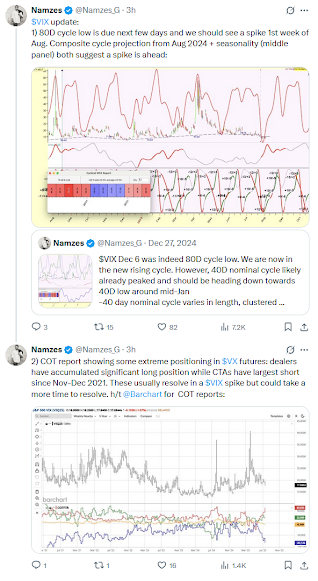S&P 500: The S&P 500 formed an 18-month cycle trough in early April 2025, followed by an 80-day cycle trough on June 23, and a recent 40-day cycle trough on July 16. A 20-week cycle trough is anticipated around mid-August, with the 20-week cycle FLD expected to provide support.
S&P 500 (daily bars): Expect a 40-day cycle peak soon, and a mid-August 20-week cycle trough.
The market is currently in a bullish trend, forming a second 40-day cycle peak soon, after which it should decline into the 20-week trough. Shorter cycle FLDs (5-day, 10-day, 20-day, 40-day, 80-day) will be monitored for peak confirmation and to generate downside targets. The trough may form above the 20-week FLD due to the bullish trend.
NASDAQ: The NASDAQ also formed an 18-month cycle trough in the
April, and an 80-day cycle trough in mid-June. A second 40-day cycle
peak is expected soon, followed by a decline into a 20-week cycle trough
in mid-August, with support at the 20-week FLD.
NASDAQ
(daily bars), same as in the S&P: 40-day cycle peak soon, and a rather shallow mid-August 20-week cycle trough.
Gold was potentially forming a significant cycle peak, possibly an 18-year cycle peak, around mid-April of 2025, but without confirmation, as its price moves in a contracting wedge and lacks the typical sharp, isolated peaks.
Gold (weekly bars): 18-year peak likely still ahead (allow 1-2 years of leeway).
Hence, doubts persist about the 18-year peak, with suggestions the April 22 high may be a 20-week or 40-week peak instead, the true 18-year peak likely still ahead due to cycle variation allowing a year or two of leeway. A 40-week cycle trough formed on May 15, and an 80-day cycle trough is expected in early August, with the price crossing below the 20-day FLD, targeting around $3,250, followed by a potential bounce.
Bitcoin (weekly bars): next 18-month cycle trough by year-end
or early 2026 (the second in the current 54-month cycle).
Bitcoin (monthly bars): 18-month and 54-month cycle peaks and troughs.
A 20-week cycle trough is expected in mid-to-late August, with a peak possibly already formed or imminent, followed by a slight decline into the trough before an 18-month cycle trough anticipated by year-end or early next year.

.PNG)




























.PNG)



















